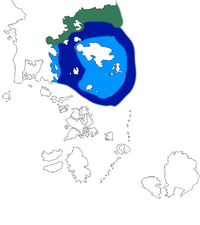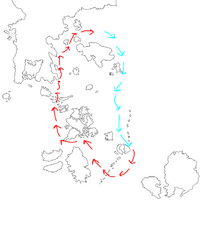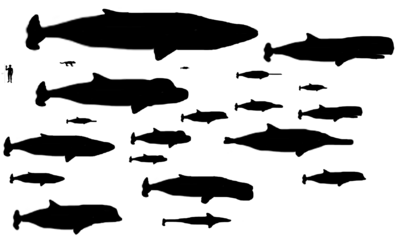Asterhaf
Asterhaf (literally, "The Eastern Sea") is a vast oceanic region located east of Scandera and northwest of Asterland. Known by various names including Nardsja, Svarthaf, Kakto Dour, and Ishashi'mo (meaning "The Northern Sea," "The Black Ocean," "The Northern Ocean," or the "Sahsi/Scanderan Sea"), the area is considered federal waters by the Absolute Royal Federation. Although the Federation does not assert as stringent a claim over this ocean as it does over the entire Vattnafalten in the south, and it does not enforce the entire region as within its exclusive economic zone (EEZ).
Asterhaf is bounded by Scandera, notably Imeriata, Vedian, and the northern ice plains to the east, and centrally surrounds Asterland and Salywa. The southern reaches include notable locations such as the island of Dragon Grave, Taranaka, and Salmo, with the far north defined by the Cairn Shore.
The sea is distinguished by its profound central depth, a result of tectonic plates gradually separating Asterland from Scandera. This geologic activity not only fosters a deep-sea environment but also leads to frequent volcanic activity, contributing to the formation of several small island chains. These islands are primarily inhabited by Scanderans, Scanderianized natives, Giels, and other ethnic groups collectively referred to as "Havsavalk" by federal authorities. Due to historical Scanderianization, these groups have either assimilated or been replaced by Scanderan settlers over the centuries.
Economically and militarily, the region is crucial, serving as a major transport hub connecting Asterland, Salywa, and Scandera. Although not as heavily utilized as the Vattnafalten, the sea has historically been vital for regional trade, especially the routes from Asterland to the Scanderan Northern Ice Plains and down to Scandera proper. Today, industries such as fishing and whaling remain significant, complemented by emerging oil drilling activities. Strategically, the region hosts substantial naval bases for the Federal and Royal fleets, ensuring control and providing a strategic point from which to defend the southern territories.
Geography
The region's geography is influenced by the divergent continental drift between the southern Scanderan and Asterland shelves, which has created a notably deep ocean. Additionally, the warm Vattnafalt Stream moderates the climate, causing heavy rainfall on the eastern Scanderan coast and contributing to the region's temperate and Arctic rainforests. Large meltwater runoffs from the islands enrich the sea with minerals, fostering annual algae blooms that support extensive marine life.
The sea is divided into five distinct areas: the northern kelp forests, the dense pine mangroves of eastern Scandera, the shallows of Asterland, the volcanic islands, and the deep black sea. These regions are interconnected, facilitating large-scale migrations of marine wildlife.
Scanderan Coast
This extensive coastal area features kelp forests and pine mangroves, hosting a biodiverse array of species, including fish, seals, walruses, cetaceans, bears, and semi-aquatic mammals. Northern sea lizards are also present, though in smaller numbers compared to the southern Vattnafalten.
The Cairn shore
At the extreme north, the "Cairn Shore" or "Brasstrand" is a cold, rocky landscape dominated by a massive kelp forest. It supports a rich ecosystem of walruses, dolphins, seals, small whales, and various other marine species. Historically, it has been home to several civilizations, including ancient pyramid builders and cairn builders, known for their necromantic practices, which led to their eventual demise at the hands of Scanderans. The modern population is somewhat Scanderianised but they also keeps a lot of traditions and languages of their Cairn builder forebears.
Eastern shallows
Surrounding Asterland, this area includes shallow sandbanks, seagrass meadows, and kelp forests, and lacks the profound depths found in the central sea.
Islands
The islands between Scandera and Asterland are volcanic in nature. Their fertile soils support birch forests, and seasonal meltwaters contribute to significant algae blooms, attracting massive schools of fish and their predators.
Deep Sea
Characterized by its depth, the deep sea region is the site of significant volcanic activity and hosts large marine fauna, including kraken squids and sea dragons. Although modern navigation is safer, the area remains treacherous due to its predatory inhabitants.
Biology
Sea Lizards
Cetaceans
In the marine ecosystems of the Asterhaf region, fish, plankton, and various species of kelp and seagrass form the foundational elements of the food web. However, the dominant species within these ecosystems are the cetaceans, with only sea lizards, Krakens, and Sea dragons capable of rivaling their dominance. Cetaceans range in size from medium-sized semi-aquatic predators that inhabit the deep pine mangroves of the eastern coast and primarily consume fish, to mid-sized seals—referred to as "sea wolves." These sea wolves are closely related to the river wolves of the Scanderan interior and represent a distinct clade from most other whales, retaining a more primitive form and not fully adapted to aquatic life like their more distant relatives.
It is important to note that in Scanderan terminology, the term "whale" is used more broadly than in many other languages. It encompasses not only cetaceans but also serpent whales, ichthyosaurs, and even large sharks and fish. The only significant exceptions to this category are non-ichthyosaur sea lizards and krakens. The term "whalefish" is used specifically to refer to whales, dolphins, and porpoises, although it typically excludes sea and river wolves.
Among the marine giants, the blue whale stands out as the largest living animal in the entire federation. Its immense size makes it a source of awe and inspiration across federal territories. While the blue whale represents the apex size of filter feeders, several smaller species of filter feeders also inhabit the sea. These species often migrate through the deeper waters but frequently travel eastward to feed on algae blooms. They may feed directly on the algae or on the plankton swarms that are attracted to the blooms.
In addition to filter feeders, many whales have evolved to prey on other marine mammals and reptiles. Species such as orcas are generally not a threat to humans unless provoked, and large predatory whales that target other filter feeders or fish eaters usually avoid humans unless they interfere. However, some mid-sized species are known to be dangerous and may actively hunt humans. For instance, the so-called "Banefish" is notorious for preying on seals, fish, and even other whales of similar size, and may include humans as prey if the opportunity arises. Another dangerous species, the "fighting fish," is highly aggressive, particularly the males, which exhibit near-suicidal aggression to protect their pods and they are known to attack even sea dragons on sight. While attacks on humans by these species are opportunistic rather than targeted hunting, they still pose a significant risk to those who come too close.
Specialist fish-eating whales are noted for their long snouts, including well-known dolphins and other larger whale species that have independently developed similar adaptations. These can range from the small mangrove dolphin, about the size of a human arm, to massive predators comparable in size to small ships. Species such as the cachalot are specialized in hunting large squids, krakens, and ammonites that inhabit these productive seas. These are commonly referred to as "squidslayer whalefish" or "blackafiskbane valefisk" in Imerian. It should be noted that some of these adaptations are the result of convergent evolution rather than shared ancestry.
Whales have had a profound impact on the cultures surrounding Asterhafet. Whaling has been a prevalent practice among these cultures, with some relying on it alongside fishing and seal hunting as a primary food source in the far north. Whales are frequently featured in local mythology and stories, often having Gods take the shape of whales in myths but also being worshiped in their own right in more primitive cultures. Whaling sacrifices are a common religious practice, and whales are prominently featured in regional heraldry and art. Scanderan sea lords, in particular, often include predatory whales in their coats of arms.
Fish
Fish are a fundamental component of the Asterhaf ecosystem and play a crucial role in the diet of nearly every animal living in or around the sea. They constitute a significant portion of the region's ecological diversity and occupy almost every ecological niche, with the exception of the largest apex predators, such as sea dragons, whales, and krakens.
Fish in the Asterhaf range in size from very small species that feed on algae and plankton to medium-sized fish that are both predators and herbivores. The largest fish, including both predatory species and herbivores, can rival smaller whales in size. Sharks and other large predatory fishes are known to hunt and feed on seals and smaller whales.
Fish are integral to the ecosystem, and almost every other clade of animals in the region relies on them in some capacity.



